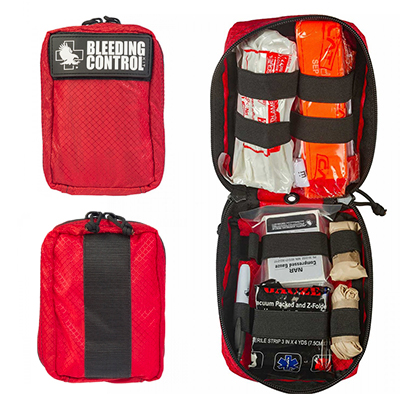A bleeding control kit is a well-equipped collection of supplies that has been specifically customized for treating severe bleeding injuries. Bleeding control is a type of first aid that helps stop the bleed following a patient’s trauma, saving valuable time and energy for the victim and first responders.
Hemorrhages (aka any blood loss from the circulatory system due to damaged blood vessels) equate to nearly 60,000 American deaths every year. As many as thirty percent of those deaths happen in the first 24 hours following a traumatic injury.
Difference Between a Bleeding Control Kit And First Aid Kit
It might be easy to confuse the two, as both kits carry many of the same items, but they have slightly different uses. A first aid kit is used for initial treatment of a variety of injuries, such as sprains, broken bones, and burns. A bleeding control kit’s sole purpose is to control heavy bleeding in order to buy enough time for a victim to get professional medical care.
Bleeding control techniques help to minimize blood loss and prevent shock by stopping or slowing a patient’s bleeding as quickly as possible, thereby allowing emergency medical services (EMS) personnel to transfer that victim to advanced medical care. You don’t have to be a first responder or healthcare provider to benefit from having a bleeding control kit. The average individual would benefit from having easy access to a basic kit in the event of a natural disaster or accident at home.
These are the seven most essential components of a bleeding control kit:
1 – Vinyl or Nitrile Gloves
The first thing that a rescuer should remember is to protect themselves. That means making sure a scene is safe before attending to victims, and also making sure that they are protected against infection and bloodborne pathogens.
Gloves are the primary line of defense for emergency medical workers and first responders so that they don’t risk infection while trying to save lives.
When applying a tourniquet or direct pressure, a rescuer could very quickly be covered in a victim’s blood. If gloves are available, the rescuer is able to change them between touching the victim and other pieces of rescue equipment, reducing the chances of cross contamination.
2 – Trauma Shears
In a life-threatening bleeding situation, there’s no time to get someone undressed. Plus, the victim’s injury may prevent them from moving. When this is the case, trauma shears are employed to quickly and efficiently remove a victim’s clothing so treatment can begin as soon as possible.
Trauma shears are not only capable of cutting through clothing and denim, but also through leather and seatbelts. The design of trauma shears allows them to glide over skin, minimizing the risk of further injury to the victim.
3 – Tourniquet
If the site of severe bleeding is located on the arm or leg of a victim, then a tourniquet should be employed to help stop bleeding. A tourniquet is not a perfect solution, it is only meant as a measure to stop bleeding until a victim can be transported to a medical facility.
A tourniquet can be improvised by using a shirt or other type of cloth tied so that it tightens around the limb. However, the best results can be achieved by using a Combat Action Tourniquet (CAT), SOF Tourniquet, SAM XT Tourniquet, or other similar tactical tourniquet.
If a wound is below the knee or elbow, then the tourniquet should be applied to the part of the limb that’s closest to the heart. If possible, you should mark the tourniquet with a permanent marker denoting the time it was applied. Tourniquets should not be left on for more than two hours, otherwise permanent tissue and muscle damage could result.
4 – Hemostatic Dressing
Tourniquets can’t be applied to wounds of the torso or head, and in those cases direct pressure must be applied to control bleeding. A clean piece of cloth will do, but a proper hemostatic dressing is even more effective at both soaking up blood and assisting the body’s natural clotting process. A hemostatic dressing, also called a bleeding control dressing, is used with direct pressure on a wound located on the head, neck, or torso.
Hemostatic dressings, such as QuikClot, were first developed by the United States military. Since then, other hemostatic dressings like WoundClot have been developed.
5 – Rolled Gauze
Having gauze is important for a bleeding control kit in the case of penetrating trauma. “Penetrating trauma” covers any injuries caused by foreign objects that pierce the skin and damage the underlying tissues. Penetrating trauma is divided into three categories: Puncture wounds, which are small holes in the skin that do not enter a body cavity, penetrating wounds, which pierce the skin and do enter tissue and/or a body cavity, and perforating wounds, which involve an object entering and exiting the body. Most severe penetrating trauma is caused by gunshots, stabbings, and explosives.
Rolled gauze can be used to hold dressings in place over puncture wounds, and can be used to pack penetrating or perforating wounds to help stop the flow of bleeding as an emergency trauma dressing. Some gauze is treated with QuikClot or other type of hemostatic agent, further enhancing its coagulative capability.
6 – Chest Seal
Chest seals are a newer addition to many bleeding control kits and trauma kits as a result of the rise in mass shootings in the United States throughout the 2000s. A chest seal’s sole purpose is to treat a specific type of penetrating trauma called a sucking chest wound.
A sucking chest wound is caused when a foreign object penetrates the chest cavity and the lung (which causes air to be drawn into the lungs from both the trachea and the new hole). Most chest seals, such as those manufactured by Hyfin, also feature one-way vents to release air that may be trapped in the chest cavity so that the lung can fully inflate.
7 – Survival Blanket
Heavy blood loss can cause a drop in a victim’s body temperature, so a survival blanket is a good addition to help keep them warm. If the bleeding victim is a child, wrapping them in a survival blanket can help to make them feel safer, as well as making them easier to transport.
Other Items To Consider For Your Bleeding Control Kit
There are some other items that you should consider placing in your bleeding control kit. While not necessarily essential, they can help when responding to a severe bleeding emergency.
Forceps are an important tool to have in case debris needs to be removed from a wound before dressing. (Large objects penetrating the body should be left in place, however.) Splints might also be needed to realign a broken limb, and a triangular bandage is also useful to have in your bleeding control kit to serve as a sling.
Public Access to a Bleeding Control Kit
The location of a bleeding control kit will impact the kit contents needed. If the bleeding control kit is located in a school, mall, or office building, it should have adequate supplies to treat multiple victims, in the event of a mass shooting. However, if a bleeding control kit is located in a private residence, it would probably only need enough supplies to treat a smaller number of individuals.
Keep in mind that it’s always better to have more supplies than you think you need rather than risk not having the right supplies when you need them the most. In the event of a natural disaster, there may be multiple members of a household requiring assistance.
If a bleeding control kit is at a gun range, it would have supplies that would be necessary for treating gunshot and shrapnel wounds. But if it’s a bleeding control kit at a factory or machine shop, the equipment should be for the treatment of amputations or blunt trauma. Many industrial locations have clearly marked bleeding control stations on the premises for that purpose.
Get Your Bleeding Control Kit Assembled
Your bleeding control kit may vary depending on the supplies in it and the environment that it’s meant to serve. Bleeding emergencies can happen anywhere, and preparedness can be the key difference between life and death.
You can make your own bleeding control kit from the components above, or you can purchase a pre-assembled one, such as this individual bleeding control kit from North American Rescue (NAR).
Whichever you choose, remember that Penn Care has everything to cover your emergency needs, like bleeding control kits, trauma kits, and automated external defibrillators (AEDs).



